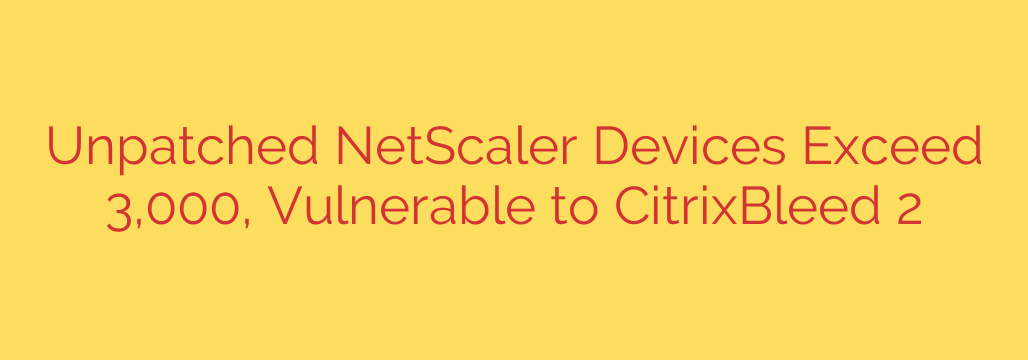
Urgent Security Alert: Thousands of NetScaler Devices Vulnerable to New “CitrixBleed 2” Exploit
A new high-severity vulnerability, nicknamed “CitrixBleed 2,” is exposing thousands of internet-facing NetScaler ADC and Gateway appliances to significant security risks. This critical flaw, tracked as CVE-2023-6549, could allow attackers to trigger a denial-of-service condition or, in specific configurations, access sensitive information.
Despite security patches being available since January 2024, recent scans reveal a troubling reality: more than 3,100 NetScaler appliances remain unpatched and publicly exposed. These vulnerable systems present an open door for malicious actors, demanding immediate attention from IT administrators and security teams.
Understanding the CitrixBleed 2 Vulnerability (CVE-2023-6549)
This vulnerability resides within the NetScaler management interface and carries two primary threats depending on the device’s configuration:
Sensitive Information Disclosure: If the appliance is configured as a Gateway (VPN virtual server, ICA Proxy, CVPN, RDP Proxy) or an AAA virtual server, attackers can potentially access session data and other confidential information. This echoes the impact of the original CitrixBleed flaw (CVE-2023-4966) that was widely exploited in 2023.
Denial of Service (DoS): Even without the specific configurations above, any vulnerable appliance is susceptible to a DoS attack. An unauthenticated, remote attacker can crash the device, disrupting critical business operations and network availability.
The widespread nature of this exposure is alarming. A global scan of internet-facing systems shows that a significant number of these unpatched devices are located in the United States and Europe, highlighting the international scope of this security risk.
Why This Demands Immediate Action
The name “CitrixBleed 2” is a deliberate reference to its predecessor, which was aggressively exploited by ransomware groups like LockBit to gain initial access to corporate networks. That history provides a clear warning: threat actors have a proven playbook for exploiting NetScaler vulnerabilities.
The existence of thousands of unpatched systems means that attackers are likely already scanning for and targeting these low-hanging-fruit opportunities. Each day that a device remains unpatched increases the likelihood of a security incident, which could range from operational downtime to a full-blown data breach. A history of active exploitation by ransomware groups makes this new vulnerability particularly dangerous.
Actionable Steps to Secure Your NetScaler Appliances
Protecting your organization from CVE-2023-6549 requires swift and decisive action. Follow these essential security measures immediately:
1. Identify Vulnerable Instances: The first step is to determine if your NetScaler ADC and Gateway appliances are running a vulnerable version. The affected versions include:
- NetScaler ADC and NetScaler Gateway 14.1 before 14.1-12.35
- NetScaler ADC and NetScaler Gateway 13.1 before 13.1-51.15
- NetScaler ADC and NetScaler Gateway 13.0 before 13.0-92.21
- NetScaler ADC 13.1-FIPS before 13.1-37.176
- NetScaler ADC 12.1-FIPS before 12.1-55.302
- NetScaler ADC 12.1-NDcPP before 12.1-55.302
2. Patch Immediately: The only definitive way to mitigate this threat is to apply the security updates. Do not delay this process. Upgrading to the recommended patched versions closes the security gap and removes the risk of exploitation.
3. Isolate the Management Interface: As a crucial security best practice, the NetScaler management interface (NSIP) should never be exposed to the internet. Ensure your network architecture restricts access to the management interface, allowing connections only from trusted internal networks. This simple step can significantly reduce the attack surface for this and future vulnerabilities.
4. Hunt for Compromise: If your patching was delayed, it is critical to scan for any Indicators of Compromise (IoCs). Review system logs for unusual activity, unexpected reboots, or signs of unauthorized access.
The window of opportunity for attackers is currently wide open. Proactive patch management is not just a best practice; it is an essential defense against determined threat actors. Administrators must act now to identify vulnerable systems and apply the necessary patches to prevent becoming the next victim of a CitrixBleed-related attack.
Source: https://www.bleepingcomputer.com/news/security/over-3-000-netscaler-devices-left-unpatched-against-actively-exploited-citrixbleed-2-flaw/








